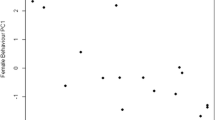Abstract
Cuttlefish have a large repertoire of body patterns that are used for camouflage and interspecific signaling. Intraspecific signaling by male cuttlefish has been well documented but studies on signaling by females are lacking. We found that females displayed a newly described body pattern termed Splotch toward their mirror image and female conspecifics, but not to males, prey or inanimate objects. Female cuttlefish may use the Splotch body pattern as an intraspecific signal, possibly to reduce agonistic interactions. The ability of females to produce a consistent body pattern in response to conspecifics and mirrors suggests that they can recognize same-sex conspecifics using visual cues, despite the lack of sexual dimorphism visible to human observers.


Similar content being viewed by others
References
Adamo SA, Hanlon RT (1996) Do cuttlefish (Cephalopoda) signal their intentions to conspecifics during agonistic encounters? Anim Behav 52:73–81
Adamo SA, Brown WM, King AJ, Mather DL, Mather JA, Shoemaker KL, Wood JB (2000) Agonistic and reproductive behaviours of the cuttlefish Sepia officinalis in a semi-natural environment. J Moll Stud 66:417–419
Boal JG, Shashar N, Grable MM, Vaughan KH, Loew ER, Hanlon RT (2004). Behavioral evidence for intraspecific signals with achromatic and polarized light by cuttlefish (Mollusca: Cephalopoda). Behaviour 141:837–861
Boal JG (1997) Female choice of males in cuttlefish (Mollusca: Cephalopoda). Behaviour 134:975–988
Boal JG (1996) Absence of social recognition in laboratory-reared cuttlefish (Sepia officinalis) L. (Mollusca: Cephalopoda). Anim Behav 52:529–537
Budelmann B (1995) The cephalopod nervous system: What evolution has made of the molluscan design. In: Breidbach O, Kutsch W (eds) The nervous system of invertebrates: An evolutionary and comparative approach. Birkhauser, Basel, pp 115–136
Corner BD, Moore HT (1980) Field observations on the reproductive behavior of Sepia latimanus. Micronesica 16:235–260
Hanlon RT, Messenger JB (1996) Cephalopod behaviour. Cambridge University Press, Cambridge
Hanlon RT, Messenger JB (1988) Adaptive coloration in young cuttlefish (Sepia officinalis L.): The morphology and development of body patterns and their relation to behaviour. Philos Trans R Soc Lond Ser B 320:437–487
Le Mao P (1985) The diet of the cuttlefish Sepia officinalis in the Normano-Bretan Gulf (France, Brittany). Cahiers de Bio Mar 26:331–340
Marler P (1977) How animals communicate. Indiana University Press, Bloomington
Mather JA (1986) A female-dominated feeding hierarchy in juvenile Sepia officinalis in the laboratory. Mar Behav Physiol 12:233–244
Maynard Smith J, Harper D (2003) Animal signals. Oxford University Press, Oxford
Messenger JB (2001) Cephalopod chromatophores: Neurobiology and natural history. Biol Rev 76:473–528
Moynihan M (1985) Communication and non-communication by cephalopods. Indiana University Press, Bloomington
Norman MD, Finn J, Tregenza T (1999) Female impersonation as an alternative reproductive strategy in giant cuttlefish. Proc R Soc Lond B 266:1347–1349
Shashar N, Rutledge PA, Cronin TW (1996) Polarization of vision in cuttlefish—concealed communication channel? J Exp Biol 199:2077–2084
Tinbergen L (1939) Zur Fortpflanzungsethologie von Sepia officinalis L. Archs néerl Zool 3:323–364
Zar JH (1999) Biostatistical analysis, 4th edn. Prentice Hall, Upper Saddle River, New Jersey
Acknowledgements
We thank Ivy Whitehorne for contributing the Splotch illustration (Fig. 1) and Dr. Jean G. Boal for helpful discussions. This research was supported by a Natural Science and Engineering Research Council of Canada (NSERC) grant to S.A. Adamo. All experiments were approved by the Dalhousie University Animal Care Committee
Author information
Authors and Affiliations
Corresponding author
Electronic Supplementary Material
S1 Female cuttlefish #2 expressing the Splotch Body Pattern
wmv 948 KB
S2 Female cuttlefish #7 expressing the Splotch Body Pattern
wmv 819 KB
S3 Female cuttlefish #4 expressing the Splotch Body Pattern
wmv 1.7 MB
Rights and permissions
About this article
Cite this article
Palmer, M.E., Calvé, M.R. & Adamo, S.A. Response of female cuttlefish Sepia officinalis (Cephalopoda) to mirrors and conspecifics: evidence for signaling in female cuttlefish. Anim Cogn 9, 151–155 (2006). https://doi.org/10.1007/s10071-005-0009-0
Received:
Revised:
Accepted:
Published:
Issue Date:
DOI: https://doi.org/10.1007/s10071-005-0009-0




